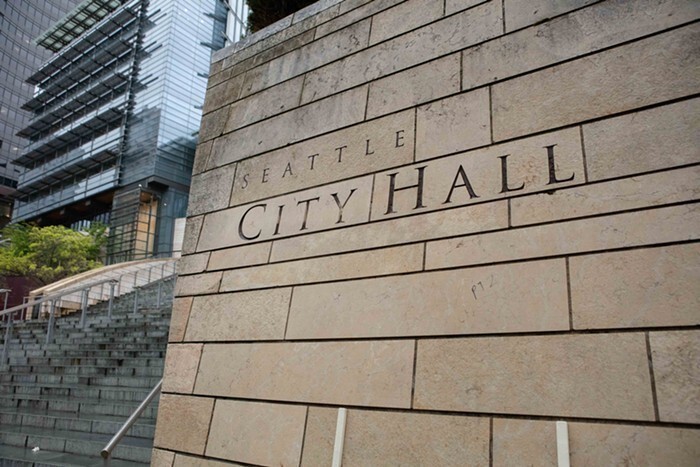March is the height of prize season in the journalism world, and this year the Seattle Times has a typically strong investigative reporting package in the various awards competitions. But the Times' post-publication tweak of that package could harm its chances of scoring coveted victories.
In mid-December, the Times published its "Coaches Who Prey" series, a comprehensive and eye-opening examination of the widespread but largely unrecognized social problem of high-school coaches who entice vulnerable teenage girls on their teams into sexual relationships. The series was the result of a difficult investigation that stretched over a year due in part to a series of expensive lawsuits brought by the state teachers' union in an effort to protect the identities of teachers against whom unsubstantiated allegations had been lodged.
The Times, to its credit, persevered; in the end, reporters Maureen O'Hagan and Christine Willmsen documented 159 coaches in Washington State who had been either reprimanded or fired for sexual misconduct in the last decade, and found that 98 of those men continued to coach or teach in spite of the discovery of their actions.
Times editors are justifiably proud of the series and believe it has a good chance of winning major honors, perhaps even the holy grail of journalism awards: a Pulitzer Prize. But while the underlying reporting in the series appears sound, questions have recently arisen about a prominent sidebar in the package.
In that sidebar, the Times reporters detailed how they ran into substantial resistance as they filed requests for what they considered public documents relevant to their investigation. Since then, the Times has reworded some of the claims in that story.
On December 14, O'Hagan and Willmsen reported on the apparent collusion between some school districts and teachers' unions to block the release to the Times of documents detailing allegations of misconduct. In particular, the piece focused largely on the Bellevue School District, where "school officials and the state's most powerful union teamed up behind the scenes to try to hide the files" by condoning "file parties" wherein teachers en masse purged their personnel files of some older and remedial reprimands before they were turned over to the Times.
After the sidebar was published, members of the Bellevue School Board complained vociferously to Times editors that the district's role in the thwart-the-Times efforts had been exaggerated and mischaracterized.
Times investigations editor James Neff, who supervised the series, strongly defends the original reporting. "We stand by the entire substance of all the four days of the series and the numerous sidebars."
Nonetheless, the Times did respond to the complaints in two ways: Though the paper did not issue a formal clarification, it significantly revised the original sidebar, taking into account the new information (and sharp denials) produced by Bellevue district representatives, and on January 11 published a Q&A with Times managing editor David Boardman in which he addressed the Bellevue School District's contentions.
In the Q&A, Boardman also stood by the piece. The introduction stated, however, "While the story was accurate based on information made available to reporters by the district and its teachers' union at the time, new details have emerged that provide more clarity on what transpired." Regarding the characterization of personnel file reviews as "file parties," the paper "should have more clearly stated" that the language came from the union rather than the district.
Neff explains that there was nothing incorrect in the original story, but the Times wanted to bend over backwards to be fair after school board members contested the statements of other sources: "Some people told us a different story after the series was published. We still don't know fully what happened. There are still questions we would like answered."
The sidebar was revised to reflect these ambiguities. While the gist of it remained largely intact, some of its findings--in particular those relating to the district's collusion in the alleged file parties--were weakened. For instance, the statement that "Bellevue school officials even let teachers purge their own records at union-organized 'file-parties' to prevent disclosure" was replaced by a more nuanced and bland statement that the union "organized a district-wide personnel-file review"; a sentence noting the district's denial that records had actually been removed was also inserted.
Still, the Times reporters seemingly powerful evidence abou the parties remained mostly unaffected. As evidence for the file-purging parties, the Times reporters cited a message to members from the Bellevue union saying it intended to host several such events in March and April 2003, at which teachers could destroy disciplinary records in their files, and said that the then president of the local Bellevue teachers' union had admitted that in one instance a teacher had been allowed to purge some notes from a file.
(The district also "invited the Washington Education Association to sue the Bellevue district" to keep records from the Times, the paper said. The WEA did sue on behalf of 36 teachers in the Bellevue, Federal Way, and Seattle districts. In April 2003, a superior-court judge ordered release of information in 21 cases, while withholding it in the other 15. The Times has appealed that decision to the state supreme court.)
But Steve Miller, the outgoing Bellevue School Board president, contested the idea that the district endorsed the file-purging party idea bruited by the union. "We really got on their case," he now says about his conversations with the Times in the days after the sidebar was published. "There was no evidence of a plan, no evidence a plan was ever approved, no evidence a purging party ever occurred."
As evidence, he produced a March 1 e-mail--not given to the Times prior to the story's publication--from Superintendent Mike Riley to school administrators ordering them not to allow such parties to take place. "Employees who wish to see the contents of their file should make an appointment with the principal, review it in the presence of the principal, then return it to the principal. Period. It is not a group activity.... The files should not leave your presence. This is a dignified, private activity. No exceptions."
On December 18, the Bellevue School Board also posted an open letter on its website questioning some of the Times' claims, and posted written statements from its 28 principals that seemed to counter the scope of the file-parties allegations. "There were no file parties and no misconduct records were ever removed," the letter flatly contends.
How the Times handled the revised sidebar raised questions in Bellevue. In the paper's web archive, for instance, no indication was provided that the piece had been altered. Neff attributes that to a simple oversight, and points out that in the stand-alone reprint of the series, a one-sentence notation was added: "This story has been updated since its December 14, 2003, publication." The same notation has now been added to the web version, he said.
But does that one sentence go far enough? And why did the Times not formally clarify the story, explaining exactly how and why they had updated it, as it might do with less high-profile pieces?
Neff says there was no reason to do so given the publication of the Boardman Q&A. The Q&A, which ran in a Sunday edition, was certainly lengthy and substantive. But members of the Bellevue School Board openly wonder if the route chosen to handle their complaints--the resort to a follow-up Q&A rather than a formal clarification--was colored by Times editors' desire to protect the series' chances of winning awards.


















